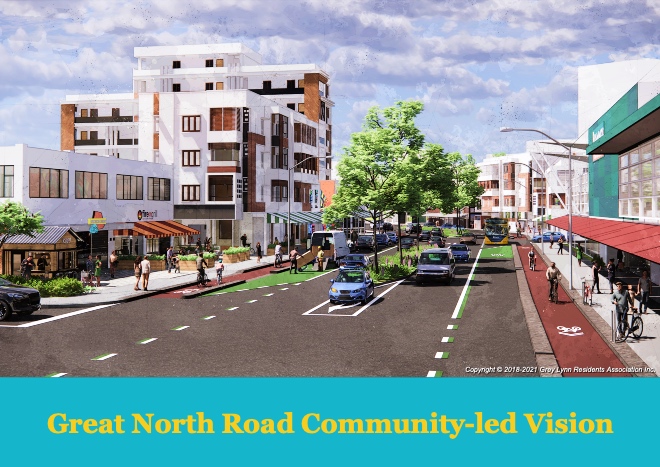
A senior University of Auckland architecture lecturer has lent his voice to the call for Auckland Transport (AT) to listen to the community before rushing through any changes to Great North Road.
Bill McKay, a regular Radio New Zealand urban issues commentator, and leader of the MArch (Prof) Professional Studies courses in the School of Architecture and Planning, was among local residents and business owners who last month joined a discussion hosted by Grey Lynn Business Association on the future of the Grey Lynn section of the road.
A community-led proposal
The GLRA’s Brandon Wilcox and David Batten opened the evening with a Powerpoint presentation that summarised our association’s community-led vision for the future of the portion of the road that runs from Ponsonby Road to the Surrey Crescent shops.
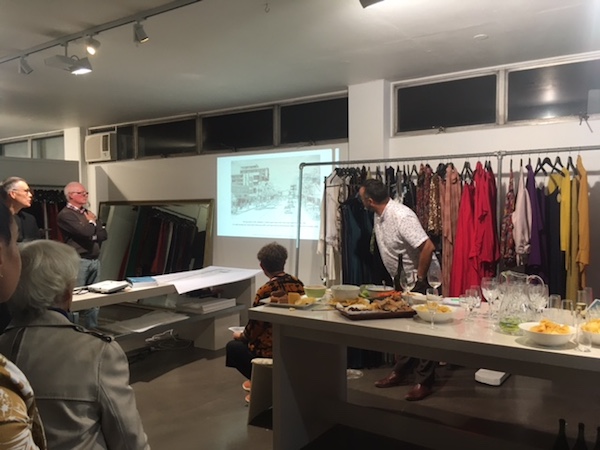

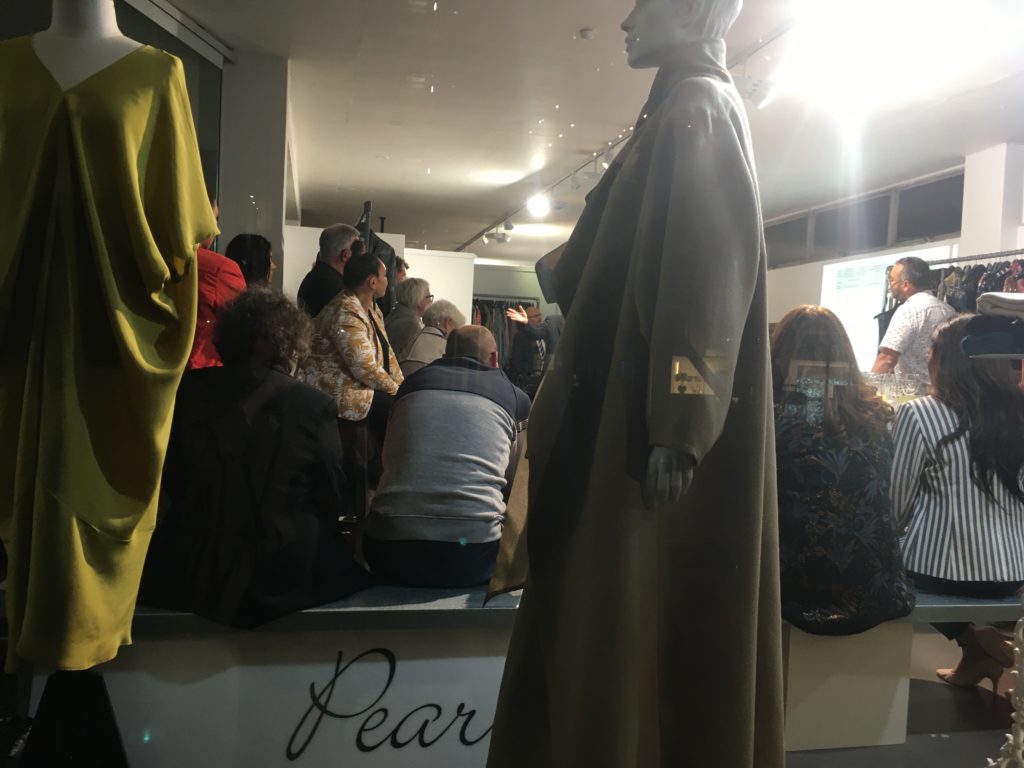
Beamed on to a white wall amongst the racks of striking silk-and-sequin designs of Grey Lynn clothing label Pearl, the presentation highlighted the community’s vision for a people-centred place with more shops, residences and businesses, and more access for pedestrians, bikes and buses – not just cars.
AT’s presenters began by outlining why roads in Auckland are a scarce commodity in a city that is growing up and out, and the urgent need to address the road safety crisis through managing speed along the ridge. Other AT priorities are removing 115 carparks to make way for buses, introducing a separated cycleway and increasing tree cover.
Prioritising a sense of place
While both parties agreed that they shared some common ground, Brandon summarised the weakness of AT’s plan as “addressing movement of traffic only – whereas what’s needed is a sense of place as well”.
David and Brandon said ultimately, the difference came down to dollars. They urged AT not to rush ahead with a plan led by budget constraints but to instead pause and get it right.
Bill McKay added his voice in support, noting that Auckland is going through “an adolescent phase”, and pointed to the success of trials like the one in High Street, which he suggested would be a better way for AT to arrive at a solution that works for both road users and the community.
Making way for a generational shift
He also challenged AT not to be short-sighted about its plans: “There’s a generational shift going on at the moment – there’s a generation coming who do not want cars; to us they were freedom, to them they’re a burden.” He ended with a plea: “Listen to the people who are in the area rather than speeding transport decisions through.”
AT undertook to respond to the feedback and our proposal in person at a date and time to be confirmed. We await their update with interest.
Listen to Bill McKay discussing Great North Road with Kathryn Ryan on Radio New Zealand

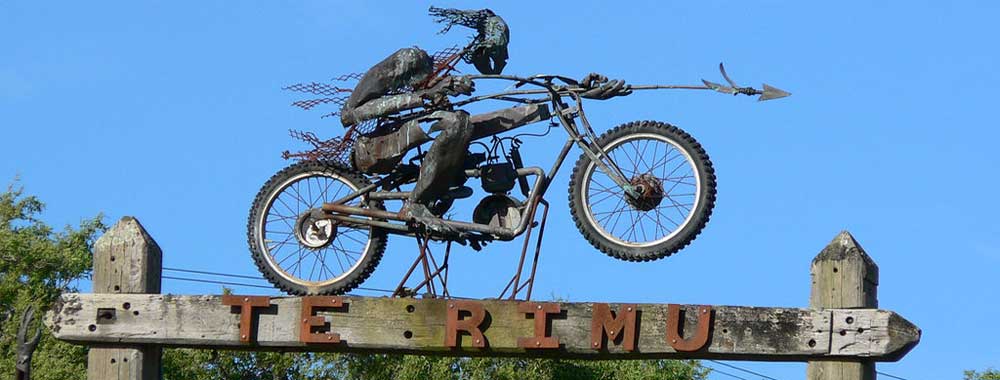
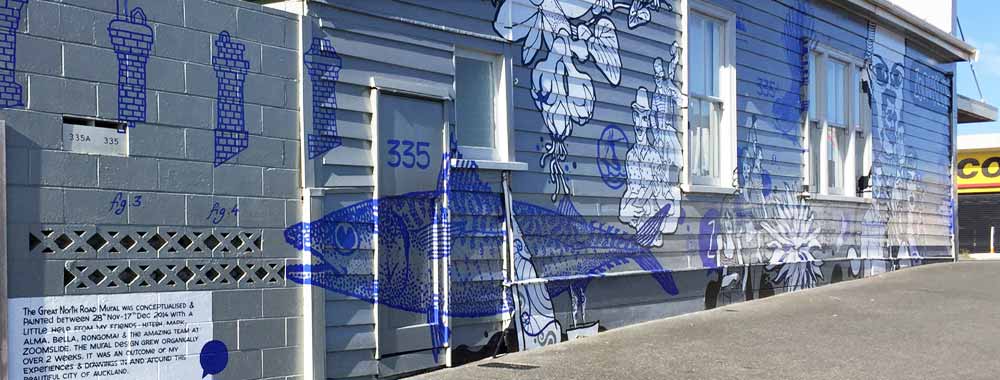



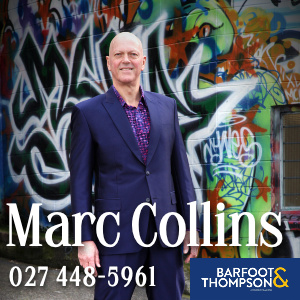
I love your proposal for the street, its fantastic, and would add more trees and soften the hardness of the streetscape.
But i think AT will not engage in meaningful consultation, as they dont on any issue like this. it will be a fight, we need to organise the community, a nd create an issue of this – otherwise they will ride over everyone and do wnat they wanted too from the beginning . Lip service
You are absolutely right. We are finding that one AT person in particular is strongly advocating for their plan (which will destroy businesses by removing 115 car parks) and doing everything he can to pick holes in the community-led vision.
The problem is that their plan is visionless and driven by a very limited budget. It emphasises ‘movement’ and ignores ‘place’. We’d rather they do nothing until they can do it right. Instead they seem intent on pushing through their visionless plan.
We are relentless though! I think they have underestimated how much backlash there is against their plan and how much support there is for the community-led vision.
Thanks for your support!
Waste of money. Spend it on nurses. People don’t think cars are burdens! The residents and business owners that think it is a terrible idea. It will destroy local business. How many car parks does your plan take out?
Dropping Gt North Rd to one Lane of traffic in each direction and building totally useless extended curblines at the entrances to ALL the side roads, will ruin the accessibility to local streets. This deliberately disadvantages only one group – LOCAL residents. Grosvenor street in particular needs to remain open to Bond Street exiting traffic, and NONE of the side roads should have unnecessary and deliberately compressed egress. That option is simply dumb! Classic AT. Ruin it for the locals, at huge expense and then move on to ruin the next suburb. St Heliers got it right by telling AT to naff off and leave their already lovely township alone. No one argues with “safety”, that is precisely why AT always use that arguement. But we don’t need speed humps every 200 metres, we don’t need restricted streets and we don’t need dedicated cycle ways. I have “done the numbers” Cycling has decreased this year by 6.5% from 2020, which was lower partly due to Covid than 2019.
Heres the key question….”How many injury /death accidents have there been in Gt North Road in the last 10 years. Almost zero! AT are “fixing a problem ” that doesnt exist- and this is what we get fir our fuel taxes! WHAT THE HECK!?
I totally agree. The curb set-outs at the intersections with side roads is being done, according to AT, for pedestrian safety – less distance to cross and only one car each side, not two. It’s part of their Vision Zero philosophy and they’ve taken it to an extreme that comes across as anti-vehicle and, as you point out in this case, anti-local residents.
To quote from AT’s website:
“Auckland Transport (AT) is adopting the Safe System approach which targets all elements of road safety for all road users. Vision Zero, an ethics-based transport safety approach, was developed in Sweden in the late 1990s. It places responsibility on the people who design and operate the transport system to provide a safe system. … Vision Zero for Tāmaki-Makaurau Auckland is an ambitious new transport safety vision that states that there will be no deaths or serious injuries on our transport system by 2050.”
I am looking forward to a street design that makes cycling safer for vulnerable children and cyclists of all ages. The theory of not doing anything until someone is killed or injured is not so good for those that are injured or killed.